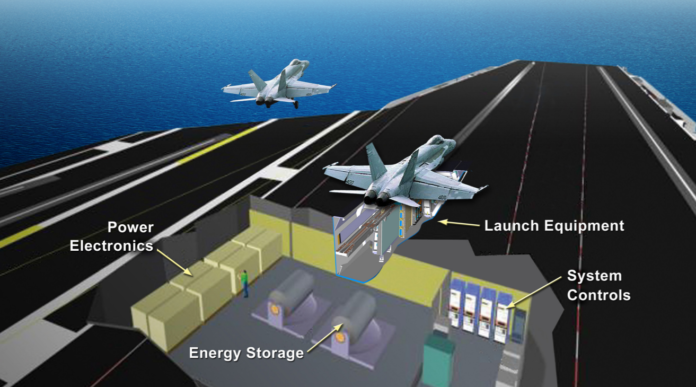The Electromagnetic Aircraft Launch System (EMALS) is a type of aircraft launching system developed by General Atomics for the United States Navy. The system launches carrier-based aircraft by means of a catapult employing a linear induction motor rather than the conventional steam piston. EMALS was first installed on the United States Navy’s Gerald R. Ford-class aircraft carrier, USS Gerald R. Ford.
EMALS (Electro-Magnetic Aircraft Launch System) uses an approach analogous to an electro-magnetic rail gun, in order to accelerate the shuttle that holds the aircraft. That approach provides a smoother launch, while offering up to 30% more launch energy potential to cope with heavier fighters. It also has far lower space and maintenance requirements, because it dispenses with most of the steam catapult’s piping, pumps, motors, control systems, etc. Ancillary benefits include the ability to embed diagnostic systems, for ease of maintenance with fewer personnel on board.
The EMALS uses a linear induction motor (LIM) to propel a carriage along a track to launch the aircraft. The linear induction motor consists of a row of stator coils with the same function as the circular stator coils in a conventional induction motor. When energized, the motor accelerates the carriage along the track. Only the section of the coils surrounding the carriage is energized at any given time, thereby minimizing reactive losses. The EMALS’ 300-foot (91 m) LIM will accelerate a 100,000-pound (45,000 kg) aircraft to 130 knots (240 km/h,150 mph).
The challenge is scaling a relatively new technology to handle the required weights and power. EMALS motor generator weighs over 80,000 pounds, and is 13.5 feet long, almost 11 feet wide and almost 7 feet tall. It’s designed to deliver up to 60 megajoules of electricity, and 60 megawatts at its peak. In the 3 seconds it takes to launch a Navy aircraft, that amount of power could handle 12,000 homes. This motor generator is part of a suite of equipment called the Energy Storage Subsystem, which includes the motor generator, the generator control tower and the stored energy exciter power supply.
EMALS benefits include:
- Increased reliability and efficiency.
- More accurate end-speed control and smoother acceleration that puts less stress on airframes.
- Expanded operational capability with increased sortie rates.
- Cost reduction over time due to decreased manning and maintenance requirements.
- Ability to launch a broader range of naval aircraft—from lightweight unmanned to heavy strike fighters—with less stress on the ship and aircraft.
- Provides 30% more launch energy capacity, allowing it to handle heavier fighters.
- Compared with steam, it provides substantial improvements in system weight, volume, and maintenance.
- Compared with steam it requires less space and maintenance requirements because it eliminates most of the steam catapult’s piping, pumps, motors, control systems, etc.
- Quieter and cooler work and living spaces for sailors.
- More intuitive maintenance software to reduce troubleshooting times.
- Ability to embed diagnostic systems, for ease of maintenance with fewer personnel on board.
- Reduces the need for energy-intensive desalination employed with steam systems.




